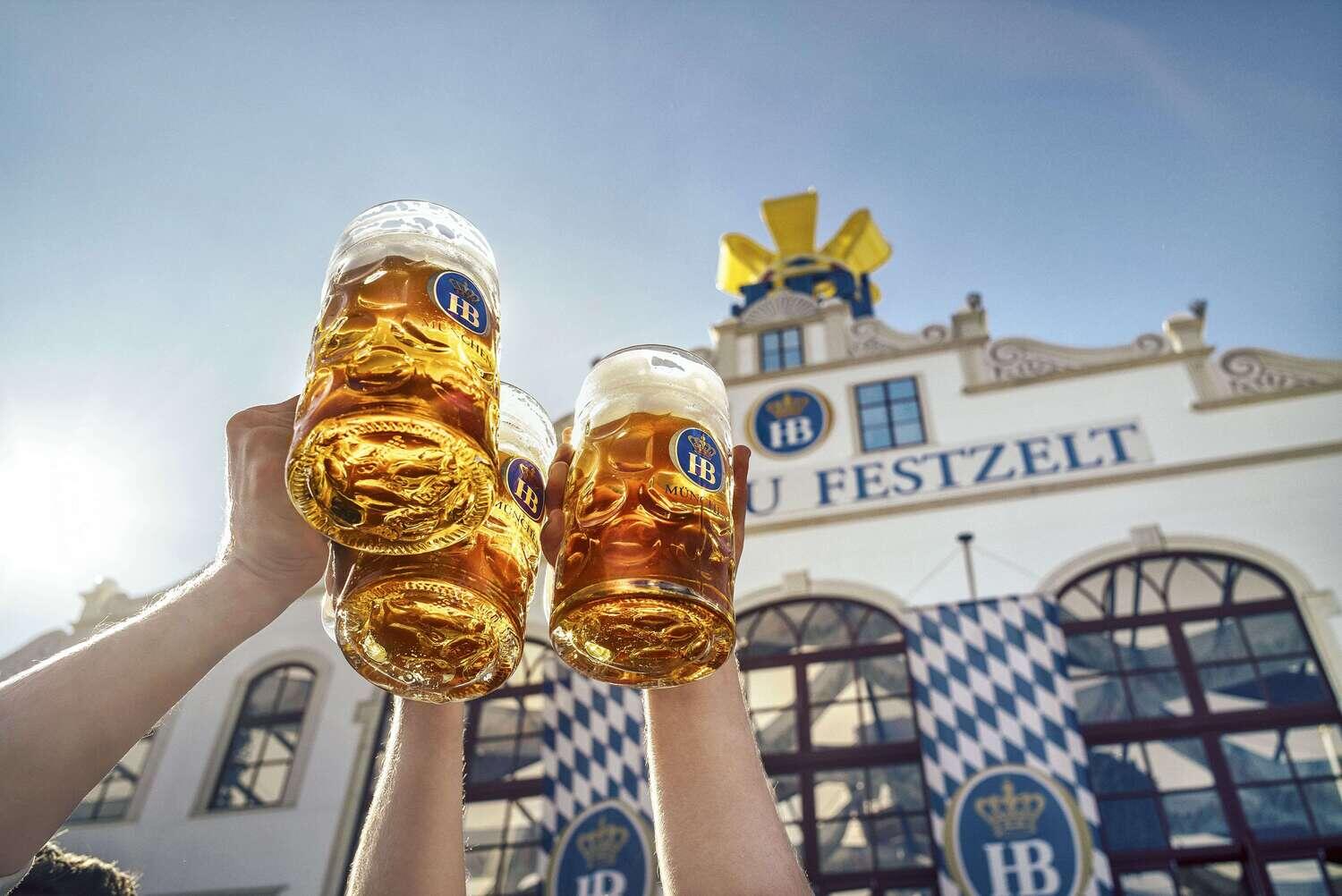How Oktoberfest Went From “I Do” To Brew
For beer fans, Oktoberfest is almost like Christmas. We anxiously await this season of merriment; counting down the days until the first keg of Otoberfestbier gets tapped. We indulge in delicious fare and share in the revelry with family and friends. Some might say it is the most wonderful time of the year!
But have you ever wondered just how Oktoberfest got its start? Did someone wake up one October day and say, Let’s throw a 16-day party? Not quite. But it does have to do with one of the most treasured ceremonies we practice today.
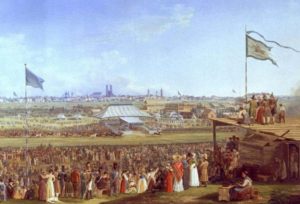
Oktoberfest was born from the most successful wedding in Bavarian history. In October of 1810, Crown Prince Ludwig was set to marry Princess Therese of Sachsen-Hildburghausen. And in true royal fashion, this was not your average wedding.
No expense was spared on behalf of the father of the groom, King Maximilian I Joseph of Bavaria. Ludwig and Therese’s wedding was a massive celebration with a 40,000 person guest count, free-flowing beer, and a 36,000-foot horse race in a large meadow just outside of town.
The celebration was deemed the reception of the century. In fact, everything was so successful that Ludwig decided a horse race should be held the following year in conjunction with the state agricultural show. Taverns and “eating houses” were also allowed to provide tempting fare; among them was the original Hofbrauhaus. Voila! Oktoberfest had arrived.
BUT WHAT ABOUT THE BEER?
Two years after the wedding, the royal brewers created a beer, especially for the festival. With a deep golden color and higher alcohol content, the world-famous Oktoberfestbier from Hofbrau Muenchen made its mark on history.
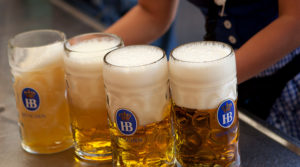
Today, Ludwig’s and Therese’s anniversary is still celebrated all over the world by thousands of guests and, of course, beer! The horse races ended in 1960 but, as they say, the show must go on.
Oktoberfest is customarily held from the third week of September until the first Sunday in October due to Munich’s lovely September weather. However, some Hofbrauhaus locations keep the party going through the end of October. Don’t threaten us with a good time!
More than the chicken dance and some cake!
Oktoberfest is celebrated in many ways all over the world. But how is it done at the place it all began, Munich, Germany?
Dating back to 1887, the opening day ceremonies begin with a four-mile parade featuring elaborate floats, bands, and more than 25,000 men, women & children. Many revelers proudly don the traditional Lederhosen and Dirndl.
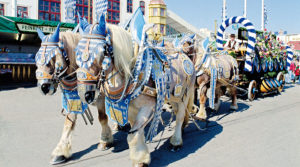
At 11 am on the dot the parade, led by the Muenchner Kindl (the little Munich city’s coat of arms), enters the grounds on the Wies’n (short for Theresienwiese, or Therese’s fields after Bavaria’s famous bride).
The mayor arrives in a festive coach followed by civic dignitaries and horse-drawn brewer’s carts decorated with flowers. At noon the parade winds its way to the “Schottenhamel” tent, which also happens to be the oldest private tent at Oktoberfest. Here, the mayor finally taps the first keg of beer and declares O’zapft is! Now the fun can really begin!
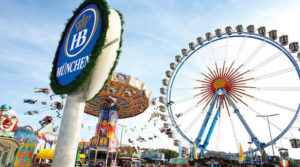
Besides the beer, another can’t-miss part of Oktoberfest in Munich is the famous Ferris wheel. Riesenrad in German, the Ferris wheel at the Oktoberfest fairgrounds is 48 meters (158 feet) high and offers riders breathtaking views of the Munich skyline and the celebration below. It is such a fairground fixture that it was even incorporated into the official Oktoberfest placards in 2002 and 2004.
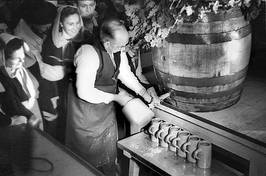
Munich’s mayor and keg tapping may seem like a tale as old as time, but did you know the Oktoberfest tradition is not a custom of Munich’s Oktoberfest?
From 1810 to 1949, no cries of “O’zapft is!” hit the ears of thirsty festers. There was no mallet or mayor to usher in the town’s most-anticipated beer festival. Sad, right?
In 1950 everything changed thanks to the then mayor, Thomas Wimmer. It was customary for the mayor to lead the parade of restaurateurs each Oktoberfest, but Wimmer was a very busy guy. During the start of 1950’s party, he was caught up at an electronics fair in town. To get to the fairgrounds, also known as the Wiesn, he cut some corners and took the shortest route. This is where the story gets good.
Rumor has it that in order to catch up to the festivities Wimmer took the shortest route to the fairgrounds, also known as the Wiesn, heading straight for the Schottenhamel’s family tent. (Fun fact: The Schottenhamel is now the largest tent at Oktoberfest, boasting more than 10,000 seats!)
He actually ran into the Schottenhamel family en route to their tent, and they kindly offered him a lift in their carriage. Legend states that in return for the ride he was jokingly requested to tap the first keg of Oktoberfestbier.
True or not, we know this for certain: minutes later Wimmer was finally in the Schottenhamel, Bürgermeister mallet in hand. 17 strokes later he pushed the tap into the barrel and declared “O’zapft is!” (Still not sure what this means? Find out here.) The people of Munich were so thrilled with this spirited display that he was asked to do the very same thing the next year. He passed this tradition onto his successors and it is now a vital part of the Oktoberfest experience. You can’t get a sip of brew without it! Tapping Time!
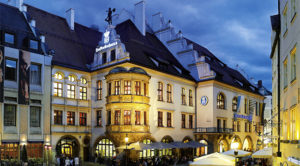
We aren’t just an exact replica of the original Hofbrauhaus in Munich, Germany. Our authenticity goes beyond the exterior to the language you may hear at the original Oktoberfest, also in Munich, Germany. Here are a few words and phrases you may hear while at our Haus during the world’s biggest beer party.
Dirndl (Dern-dull) The traditional German dress you’ll see on our lovely hostesses and waitresses, as well as guests who love to get into the spirit of Oktoberfest. They are known for their asset-enhancing powers.
Lederhosen (Lay-der-hose-in) This literally translates to “leather pants.” You’ll see a lot of men sport these trendy trousers in all kinds of styles (just check out our band!)
Guten Appetit! (goo-ten app-a-teet) How we at the Haus say wish you bon appetite.
Noch ein Bier, bitte! (nock ine beer bit-a) You’ll definitely want to commit this to memory; it’s how you ask for “Another beer, please!”
Prost! (Prōst) If you’ve ever been to our Haus you’ve definitely heard this term more than once. This is how we say, “Cheers!” In the commands form our bands you’ll also hear ein Prosit which means “a toast.”
Brezen (Bray-tsun) Pretzel. There’s no shortage of these twisted traditions that we import straight from Germany to you.
Remember how we mentioned the commands of our band? These are other terms you may hear from others who take the stage, including our celebrity keg tappers.
O’zapft is! (Ō-tsapft is) literally means “It’s tapped!”. This is the opening cheer when the first keg is tapped, kicking off Oktoberfest. See what leads up to this important declaration at Munich’s Oktoberfest here.
Schunkeln (Shoon-kulln) It’s the ideal drinking “dance” because you don’t even have to stand up! Just stay seated and when the Schunkeln song comes on, lock arms with your neighbor and sway side to side.
Eins, zwei, drei (ines tsvy dry) “One, two, three” You’ll hear this a lot, like at the start of our stein-holding contests. Here’s how to get really legit and count with your fingers in German: one is the thumb, two is thumb and forefinger, and three is the thumb, forefinger, and middle finger.
Oans, zwoa, g’suffa! (ōnns tswō g’zoo-fa) “One, two, drink up!” Enough said.
Zicke zacke, zicke zacke, hoi hoi hoi! (tsick-a tsack-a, tsick-a tsack-a, hoy hoy hoy) Another common band call-out, usually followed by Prost! and a hearty chug of beer.
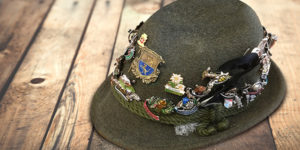
If you’ve been to our Haus this Oktoberfest you may have seen people other than our amazing staff donning traditional Bavarian attire. You may even know that the women are wearing Dirndl and the men Lederhosen, but we think it’s time you took that knowledge to the next level. And we’re here to help.
Let’s start from the top and talk about our famous headgear, the Tyrolean hat (Tirolerhut if you want to get really authentic).
These felt or wool wonders originally came from the Tyrol in the Alps (now part of Italy and Austria). You’ll most commonly find them with a pheasant or ostrich feather, but fancier versions boast goat or boar hair. Traditionally the size of the feather or tuft of hair would reveal just how wealthy you were (or weren’t). The bigger it was the more money you had—show us the feathers!
Aside from bank account size, you can also show off your interest and wanderlust by adding pewter pins that represent places you’ve traveled or what you like to do. It’s like a much cooler scrapbook!
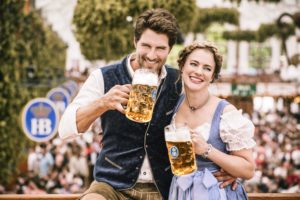
We mentioned Lederhosen and the Dirndl first, but did you know these are actually the Bavarian costume known as Tracht?
The Tracht tradition harkens back to 1626 when the Bavarian Prince-Elector Maximilian I created a dress code that divided society into seven groups: common peasants, common townspeople, merchants, traders, minor aristocracy, knights, and lords. Peasants and common townspeople did not have any special garments to mark their status, but they quickly became synonymous with Lederhosen and Dirndl. Today, these traditional looks are worn for leisure throughout Bavaria and even Austria, but they have taken on a more ornate style like what you’d see at beer festivals like Oktoberfest.
Follow the Leder
Leder translates to leather and Hosen to pants. Put the two together and what do you have? Lederhosen!
Traditionally Lederhosen is worn with high socks that can hit at the knees or you may also see smaller legwarmer-style bands around more well-endowed calves. Tradition also has men sporting plain shirts, but today’s whippersnappers like to pair their Lederhosen with colorful plaid shirts. Full costume may also have suspenders, but all true Lederhosen have a certain color embroidery or insignia to show off which region you come from.
Here’s a “fun” fact that we can neither confirm nor deny. Rumor has it Lederhosen pants are never to be washed in order to keep the leather moist. Do with that what you will. No judgment here.
Girl Power
The term Dirndl originally referred to a young woman or a girl, but today it is so much more!
The Dirndl, or female dress of Tracht, was generally a blouse, bodice, full skirt, and an apron as it was worn for work around the house or farm in its inception. Summer and winter styles varied to accommodate the weather. The summer Dirndl featured lightweight cotton and a short-sleeved blouse worn under sleeveless, tailored bodices, while the winter dirndl was often made of heavy cotton, linen, or wool and had long sleeves, warm skirts, and aprons.
As with the men, the younger women of today like to wear their Dirndls in a way that battles tradition; with shorter skirts that skim the knees. We can’t say we mind.
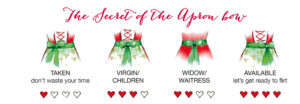
But there’s a Dirndl tradition that isn’t going anywhere anytime soon; its ability to display the status of a lady. Want to know if that cute girl eyeing you from behind her stein is taken? Just check out how her apron ribbon is tied.
To the left: She’s single. Go ahead and ask if she comes here often.
To the right: Engaged or married. Don’t touch!
In the back: She is widowed. It is also for waitresses, like the ones who treat you so well at our Haus.
In the middle: This is for young girls.
